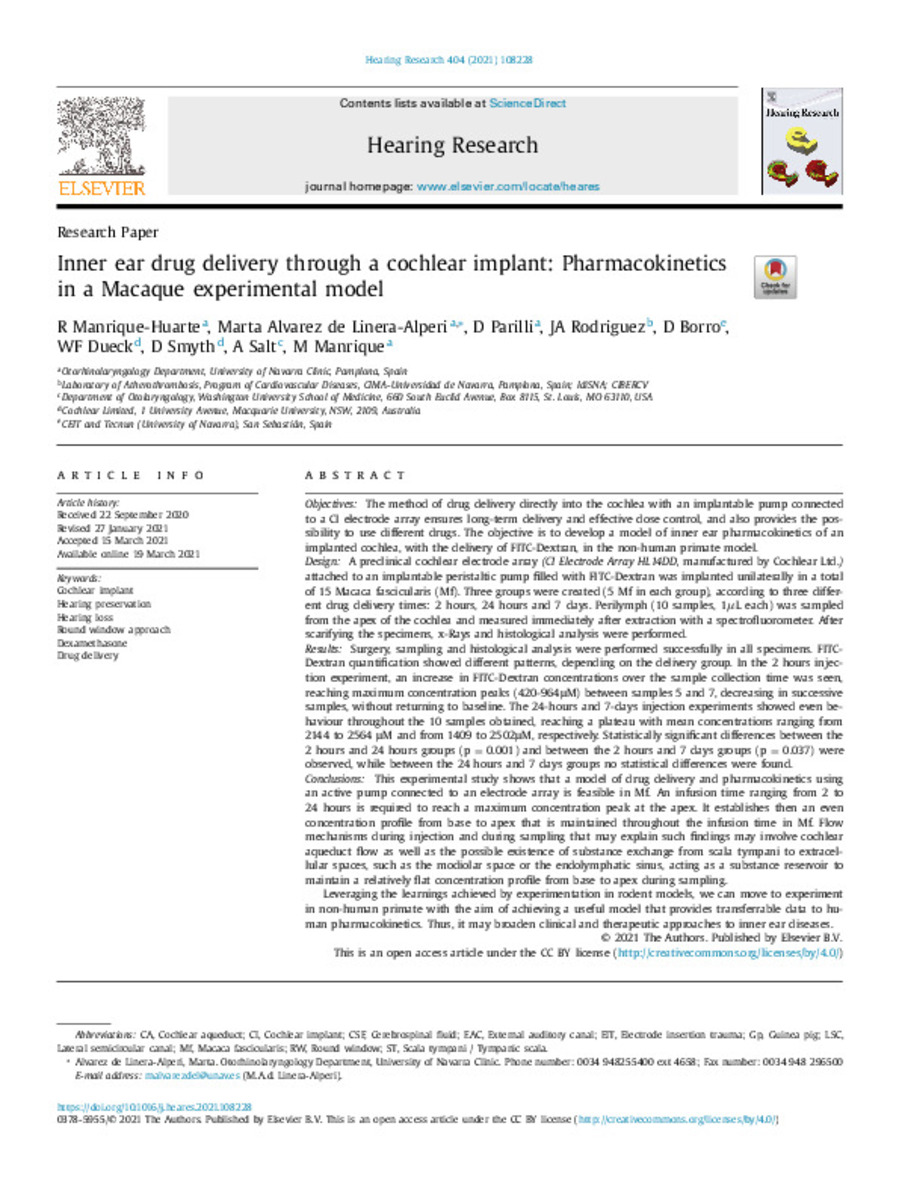Full metadata record
| DC Field | Value | Language |
|---|---|---|
| dc.creator | Raquel | - |
| dc.creator | Álvarez-de-Linera-Alperi, M. (Marta) | - |
| dc.creator | Parilli, D. (Daniella) | - |
| dc.creator | Rodriguez, J.A. (José Antonio) | - |
| dc.creator | Borro-Yagüez, D. (Diego) | - |
| dc.creator | Dueck, W.F. (Wolfram F.) | - |
| dc.creator | Smyth, D. (Daniel) | - |
| dc.creator | Salt, A. (Alec) | - |
| dc.creator | Manrique, M. (Manuel) | - |
| dc.date.accessioned | 2022-06-02T08:13:11Z | - |
| dc.date.available | 2022-06-02T08:13:11Z | - |
| dc.date.issued | 2021 | - |
| dc.identifier.citation | Manrique-Huarte, R. (Raquel); Álvarez-de-Linera-Alperi, M. (Marta); Parilli, D. (Daniella); et al. "Inner ear drug delivery through a cochlear implant: pharmacokinetics in a macaque experimental model". Hearing Research. (404), 2021, 108228 | es |
| dc.identifier.issn | 0378-5955 | - |
| dc.identifier.uri | https://hdl.handle.net/10171/63603 | - |
| dc.description.abstract | Objectives: The method of drug delivery directly into the cochlea with an implantable pump connected to a CI electrode array ensures long-term delivery and effective dose control, and also provides the pos- sibility to use different drugs. The objective is to develop a model of inner ear pharmacokinetics of an implanted cochlea, with the delivery of FITC-Dextran, in the non-human primate model. Design: A preclinical cochlear electrode array (CI Electrode Array HL14DD, manufactured by Cochlear Ltd.) attached to an implantable peristaltic pump filled with FITC-Dextran was implanted unilaterally in a total of 15 Macaca fascicularis (Mf). Three groups were created (5 Mf in each group), according to three differ- ent drug delivery times: 2 hours, 24 hours and 7 days. Perilymph (10 samples, 1μL each) was sampled from the apex of the cochlea and measured immediately after extraction with a spectrofluorometer. After scarifying the specimens, x-Rays and histological analysis were performed. Results: Surgery, sampling and histological analysis were performed successfully in all specimens. FITC- Dextran quantification showed different patterns, depending on the delivery group. In the 2 hours injec- tion experiment, an increase in FITC-Dextran concentrations over the sample collection time was seen, reaching maximum concentration peaks (420-964μM) between samples 5 and 7, decreasing in successive samples, without returning to baseline. The 24-hours and 7-days injection experiments showed even be- haviour throughout the 10 samples obtained, reaching a plateau with mean concentrations ranging from 2144 to 2564 μM and from 1409 to 2502μM, respectively. Statistically significant differences between the 2 hours and 24 hours groups (p = 0.001) and between the 2 hours and 7 days groups (p = 0.037) were observed, while between the 24 hours and 7 days groups no statistical differences were found. Conclusions: This experimental study shows that a model of drug delivery and pharmacokinetics using an active pump connected to an electrode array is feasible in Mf. An infusion time ranging from 2 to 24 hours is required to reach a maximum concentration peak at the apex. It establishes then an even concentration profile from base to apex that is maintained throughout the infusion time in Mf. Flow mechanisms during injection and during sampling that may explain such findings may involve cochlear aqueduct flow as well as the possible existence of substance exchange from scala tympani to extracel- lular spaces, such as the modiolar space or the endolymphatic sinus, acting as a substance reservoir to maintain a relatively flat concentration profile from base to apex during sampling. Leveraging the learnings achieved by experimentation in rodent models, we can move to experiment in non-human primate with the aim of achieving a useful model that provides transferrable data to hu- man pharmacokinetics. Thus, it may broaden clinical and therapeutic approaches to inner ear diseases. | es_ES |
| dc.description.sponsorship | This project was funded by Cochlear Limited. | es_ES |
| dc.language.iso | eng | es_ES |
| dc.publisher | Elsevier | es_ES |
| dc.rights | info:eu-repo/semantics/openAccess | es_ES |
| dc.subject | Cochlear implant | es_ES |
| dc.subject | Hearing preservation | es_ES |
| dc.subject | Hearing loss | es_ES |
| dc.subject | Round window approach | es_ES |
| dc.subject | Dexamethasone | es_ES |
| dc.subject | Drug delivery | es_ES |
| dc.title | Inner ear drug delivery through a cochlear implant: pharmacokinetics in a macaque experimental model | es_ES |
| dc.type | info:eu-repo/semantics/article | es_ES |
| dc.description.note | This is an open access article under the CC BY license | es_ES |
| dc.identifier.doi | 10.1016/j.heares.2021.108228 | - |
| dadun.citation.number | 404 | es_ES |
| dadun.citation.publicationName | Hearing Research | es_ES |
| dadun.citation.startingPage | 108228 | es_ES |
Files in This Item:
Statistics and impact
Items in Dadun are protected by copyright, with all rights reserved, unless otherwise indicated.






